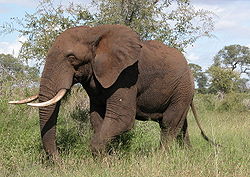Proboscidean
| Proboscidea Temporal range: Paleocene-Holocene 60.0–0 Ma |
|
|---|---|
 |
|
| African bush elephant, Loxodonta africana | |
| Scientific classification | |
| Kingdom: | Animalia |
| Phylum: | Chordata |
| Class: | Mammalia |
| Clade: | Tethytheria |
| Order: |
Proboscidea Illiger, 1810 |
| see below | |
|
Elephantidae |
|
Elephantidae
†Choerolophodontidae †Hemimastodontidae
†Amebelodontidae
†Gomphotheriidae
†Mammutidae
†Stegodontidae
†Barytheriidae
†Deinotheriidae
†Moeritheriidae
†Numidotheriidae
†Palaeomastodontidae
†Phiomiidae
The Proboscidea (from the Greek προβοσκίς and the Latin proboscis) are a taxonomic order of afrotherian mammals containing one living family, Elephantidae, and several extinct families. This order, first described by J. Illiger in 1811, encompasses the trunked mammals. Later proboscideans are distinguished by tusks and long, muscular trunks; these features are less developed or absent in early proboscideans. Proboscidea may have produced the largest land mammal of all time in the form of Palaeoloxodon namadicus, which may have weighed up to 22 t (24.3 short tons), with a shoulder height of up to 5.2 metres (17.1 ft), surpassing several sauropod dinosaurs.
...
Wikipedia
